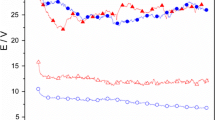Summary.
Different structures of the interglobular space or voids between self-organized nanoparticles lead to differences in the measurable magnetic properties of single-domain particle chains of similar composition, grain size, and amorphous structure of the single globules. The volumes and radii of nanoparticles obtained by application of a magnetic field (3 to 15 nm) are larger than those determined without application of a magnetic field during the borohydride reduction process. Two types of hydrogen containing nanotubes with diameters of up to 2 (small-size containers) and 5 nm (large-size containers) are produced using as a driving force the domain wall formation energy between ferromagnetic nanoparticles with quantum size effected dimensions prepared by this reduction method at room temperature and ambient atmosphere. Nanoscale hydrogen containers can be used instead of MeH nanoparticle electrodes as perfect energy charge transfer media of high efficiency (close to 100%) using Li ion electrolytes. No influence on the electrode temperature and no participation of OH− and H2O in the main charge/discharge transfer reactions were observed.
Similar content being viewed by others
Author information
Authors and Affiliations
Additional information
Received October 25, 2001. Accepted (revised) January 3, 2002
Rights and permissions
About this article
Cite this article
Dragieva, I., Deleva, C., Mladenov, M. et al. Self-Organization of Magnetic Nanoparticles and Inclusion of Hydrogen by Borohydride Reduction. Monatshefte fuer Chemie 133, 807–814 (2002). https://doi.org/10.1007/s007060200052
Issue Date:
DOI: https://doi.org/10.1007/s007060200052



